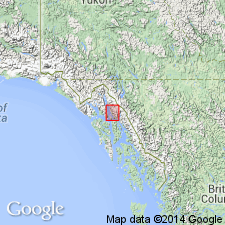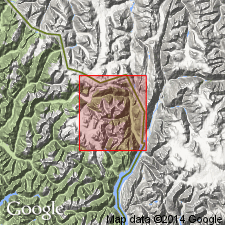
- Usage in publication:
-
- "Bear River formation"
- Modifications:
-
- Areal extent
- AAPG geologic province:
-
- Alaska Southeastern region
Summary:
"Bear River formation" of McConnell (1913) is extended from Canadian side of Salmon River basin to American side of district, southeastern AK. Described by McConnell (1913) as series of massive and fragmental greenstone which include "fine, medium, and coarse volcanic breccias or agglomerates, tuffs, bands, and areas of massive porphyrites and occasional argillaceous bands, p.63-64." On American side unit is intruded by masses of quartz diorite and associated granitic rocks, members of Coast Range intrusive series.
Source: GNU records (USGS DDS-6; Menlo GNULEX).

- Usage in publication:
-
- Bear River formation
- Modifications:
-
- Not used
- AAPG geologic province:
-
- Alaska Southeastern region
Summary:
Rocks of "Bear River formation" on American side of Salmon River basin are mapped in Hyder district as lower part of Hazelton group. Described as greenstone tuff and some volcanic breccias and slate. Age given as Jurassic(?) on map legend. [Hanson (1923) in Canada Geological Survey Summary Report Part A, p.35A states "name Hazelton group" is preferable to the name "Bear River formation."]
Source: GNU records (USGS DDS-6; Menlo GNULEX).
For more information, please contact Nancy Stamm, Geologic Names Committee Secretary.
Asterisk (*) indicates published by U.S. Geological Survey authors.
"No current usage" (†) implies that a name has been abandoned or has fallen into disuse. Former usage and, if known, replacement name given in parentheses ( ).
Slash (/) indicates name conflicts with nomenclatural guidelines (CSN, 1933; ACSN, 1961, 1970; NACSN, 1983, 2005, 2021). May be explained within brackets ([ ]).

